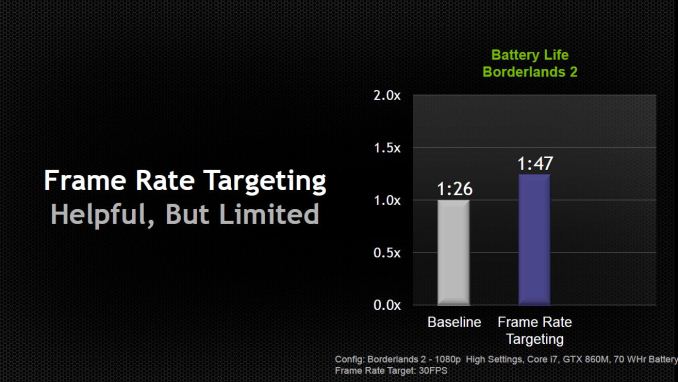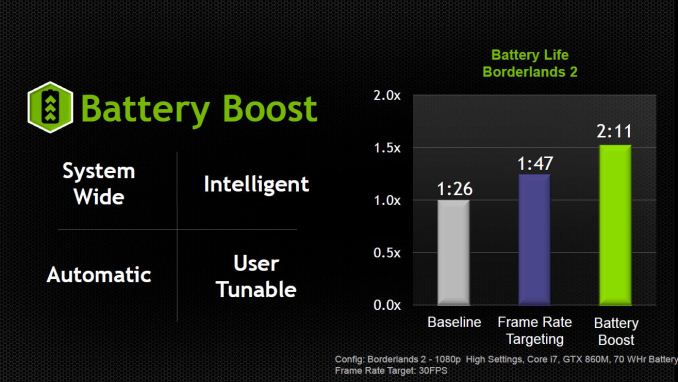NVIDIA’s GeForce 800M Lineup for Laptops and Battery Boost
by Jarred Walton on March 12, 2014 12:00 PM ESTNew for GTX 800M: Battery Boost
While the core hardware features have not changed in most respects – Maxwell and Kepler are both DX11 parts that implement some but not all of the DX 11.1 features – there is one exception. NVIDIA has apparently modified the hardware in the new GTX 800M chips to support a feature they’re calling Battery Boost. The short summary is that with this new combination of software and hardware features, laptops should be able to provide decent (>30 FPS) gaming performance while delivering 50-100% more battery life during gaming.
This could be really important for laptop gaming, as many people have moved to tablets and smartphones simply because a laptop doesn’t last long enough off AC power to warrant consideration. Battery Boost isn’t going to suddenly solve the problem of a high-end GPU and CPU using a significant amount of power, but instead of one hour (or less) of gaming we could actually be looking at a reasonable 2+ hours. Regardless, NVIDIA is quite excited to see where things go with Battery Boost, and we’ll certainly be testing the first GTX 800M laptops to provide some of our own measurements. Let’s get into some of the details of the implementation.
First, Battery Boost will require the use of NVIDIA’s GeForce Experience (GFE) software. You can see the various settings in the above gallery, though the screenshots are provided by NVIDIA so we have not yet been able to test this. Battery Boost builds on some of the already existing features like game profiles and optimizations, but it adds in some additional tweaks. Each GFE game profile on a laptop with Battery Boost will now have options for plugged in and battery power settings, and along with that setting is the ability to set a target frame rate (with 30 being commonly recommended as a nice balance between smoothness and reducing power use).
NVIDIA went into quite a bit of detail explaining how Battery Boost is more than simply targeting a lower average frame rate. That’s certainly a large part of the power savings, but it’s more than just capping the frame rate at 30 FPS. NVIDIA provided some information with a test laptop running Borderlands 2 where the baseline measurement was 86 minutes of battery life; turning on frame rate targeting at 30 FPS improved battery life by around 25% to 107 minutes, while Battery Boost is able to further improve on that result by another 22% and deliver 131 minutes of gameplay.
NVIDIA didn’t reveal all the details of what they’re doing, but they did state that Battery Boost absolutely requires a new 800M GPU – that’s it’s not a purely software driven solution. It’s an “intelligent” solution that has the drivers monitoring all aspects of the system – CPU, GPU, RAM, etc. – to reduce power draw and reach maximum efficiency. I suspect some of the “secret sauce” comes by way of capping CPU clocks, since most games generally don’t need the CPU running at maximum Turbo Boost to deliver decent frame rates, but what else might be going on is difficult to say. It also sounds as though Battery Boost requires certain features in the laptop firmware to work, which again would limit the feature to new notebooks.
Besides being system wide and intelligent, NVIDIA has two other “talking points” for Battery Boost. It will be automatic – unplug and the Battery Boost settings are enabled; plug in and you switch back to the AC performance mode. That’s easy enough to understand, but there’s a catch: you can’t have a game running and have it switch settings on-the-fly. That’s not really surprising, considering many games require you to exit and restart if you want to change certain settings. Basically, if you’re going to be playing a game while unplugged and you want the benefits of Battery Boost to be active, you’ll need to unplug before starting the game.
As for being user tunable, the above gallery already more or less covers that point – you can customize the settings for each game within GFE. I did comment to NVIDIA that it would be good to add target frame rate to the list of customization options on a per-game basis, as there are some games where you might want a slightly higher frame rate and others where lower frame rates would be perfectly adequate. NVIDIA indicated this would be something they can add at a later date, but for now the target frame rate is a global setting, so you’ll need to manually change it if you want a higher or lower frame rate for a specific game – and understand of course that higher frame rates will generally increase the load on the GPU and thus reduce battery life.
There’s one other aspect to mobile gaming that’s worth a quick note. Most high-end gaming laptops prior to now have throttled the GPU clocks when unplugged. This wasn’t absolutely necessary but was a conscious design decision. In order to maintain higher clocks, the battery and power circuitry would need to be designed to deliver sufficient power, and this often wasn’t considered practical or important. Even with a 90Wh battery, the combination of a GTX-class GPU and a fast CPU could easily drain the battery in under 30 minutes if allowed to run at full performance. So the electrical design power (EDP) of most gaming notebooks until now has capped GPU performance while unplugged, and even then battery life while gaming has typically been less than an hour. Now with Battery Boost, NVIDIA has been working with the laptop OEMs to ensure that the EDP of the battery subsystem will be capable of meeting the needs of the GPU.
Your personal opinion of Battery Boost and whether or not it’s useful will largely depend on what you do with your laptop. Presumably the main reason for getting a laptop instead of a desktop is the ability to be mobile and move around the house or take your PC with you, and Battery Boost should help improve the mobility aspect for gaming. If you rarely/never game while unplugged, it won’t necessarily help in any way but then it won’t hurt either. I suspect many of us simply don’t bother trying to game while unplugged because it drains the battery so quickly, and potentially doubling your mobile gaming time will certainly help in that respect. It’s a “chicken and egg” scenario, where people don’t game because it’s not viable and there’s not much focus on improving mobile gaming because people don’t play while unplugged. NVIDIA is hoping by taking the first step to improving mobile battery life that they can change what people expect from gaming laptops going forward.



















91 Comments
View All Comments
JarredWalton - Wednesday, March 12, 2014 - link
They did drop the "GT" on the 840M/830M/820M.JarredWalton - Wednesday, March 12, 2014 - link
And adding to that, keeping GTX allows them the ability to say, "GTX is required for Battery Boost, GameStream, and ShadowPlay."jeffbui - Wednesday, March 12, 2014 - link
Is there a reason why the GPUs have been stuck at the 28nm node for so long? IIRC the 600 series was also a 28nm part.TheinsanegamerN - Wednesday, March 12, 2014 - link
simple. TSMC's 20nm process STILL isnt ready for mass use. until they are finished, both AMD and NVIDIA are stuck at 28nm. it's too bad, as laptop GPUs are screaming for 20nm gpus.Guspaz - Wednesday, March 12, 2014 - link
GeForce Experience is pretty awesome. It used to be that whenever I got a new game, I'd have to spend a lot of time trying to figure out the right settings for it; the default settings would usually either run way too slow or way too fast. But with GeForce experience, they've already tested the game with the same CPU and GPU that I've got, and its defaults are generally a good balance of quality and performance. So what used to be an involved process of play-tweak-play-tweak-play is now just a "mash button and go".That said, it could still use some polish. I don't know if it's still in beta, but it feels like it. It's not uncommon for it to start reporting "game cannot be optimized" for games that it DOES support (and that you have previously optimized), which usually requires a reboot. And a few months ago nVidia did a self-update that caused it to go completely nuts, locking up the machine (a trip to their forums indicated it happened to everybody who got the update before they fixed it).
Concillian - Wednesday, March 12, 2014 - link
"Where things get a little interesting is when we get to the GTX 860M. As we’ve seen in the past, NVIDIA will have two different models of the 860M available, and they’re really not very similar (though performance will probably be pretty close)."no... performance won't be close. This is a laptop, where power efficiency is part of performance, and you me, and the author all know power consumption of the "Maxwell 860M" is going to be less than the "Kepler 860M" the article should be absolutely SLAMMING nVidia for calling two very different parts the same thing. The video card numbering schemes are confusing enough to laymen (I get asked to try to explain it regularly, since I'm the go to hardware guy in my circle of friends, relatives, co-workers, casual acquaintances and all their friends...) It's going to be impossible to tell them that it depends on which GTX860 they get and they probably can't tell which they'll get until they get the computer...
JarredWalton - Wednesday, March 12, 2014 - link
We've complained many times about overlapping names in the past. There were for instance two completely different versions of the GT 555M (which later became the GT 635M I believe). And performance and battery life are not "the same" -- particularly since the GPU is usually off when you're on battery power. If you want to play games while unplugged, well, there it could be a different story. Anyway, we pointed it out, said it was a dumb overlap more or less (the "interesting" was meant as a sarcastic interesting, not a "wow, this is really interesting"; perhaps that wasn't properly conveyed though I'd suggest the rest of the text supports that), and moved on. If the Kepler variant is widely used, we'll certainly complain about it.Runamok81 - Wednesday, March 12, 2014 - link
Best news here? nVidia finally dropped the silly GTX suffix. Bump that stock price. Sanity is prevailing.Death666Angel - Wednesday, March 12, 2014 - link
Nope.Anders CT - Wednesday, March 12, 2014 - link
GTX 860M and GTX 860M are two different GPU's using different architectures?That is a pretty lame naming scheme.